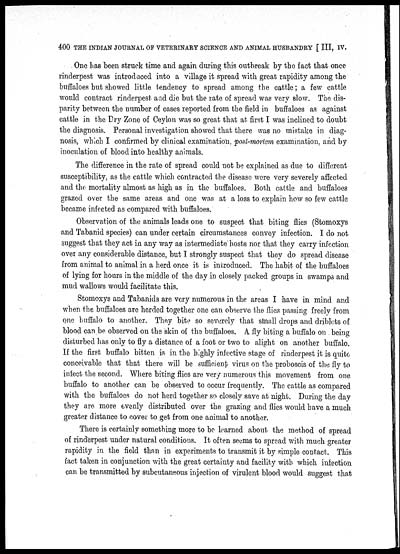Medicine - Veterinary > Veterinary colleges and laboratories > Indian journal of veterinary science and animal husbandry > Volume 3, 1933 > Original articles > Correspondence
(501) Page 400
Download files
Individual page:
Thumbnail gallery: Grid view | List view

400 THE INDIAN JOURNAL OF VETERINARY SCIENCE AND ANIMAL HUSBANDRY [ III, IV.
One has been struck time and again during this outbreak by the fact that once
rinderpest was introduced into a village it spread with great rapidity among the
buffaloes but showed little tendency to spread among the cattle ; a few cattle
would contract rinderpest and die but the rate of spread was very slow. The dis-
parity between the number of cases reported from the field in buffaloes as against
cattle in the Dry Zone of Ceylon was so great that at first I was inclined to doubt
the diagnosis. Personal investigation showed that there was no mistake in diag-
nosis, which I confirmed by clinical examination, post-mortem examination, and by
inoculation of blood into healthy animals.
The difference in the rate of spread could not be explained as due to different
susceptibility, as the cattle which contracted the disease, were very severely affected
and the mortality almost as high as in the buffaloes. Both cattle and buffaloes
grazed over the same areas and one was at a loss to explain how so few cattle
became infected as compared with buffaloes.
Observation of the animals leads one to suspect that biting flies (Stomoxys
and Tabanid species) can under certain circumstances convey infection. I do not
suggest that they act in any way as intermediate hosts nor that they carry infection
over any considerable distance, but I strongly suspect that they do spread disease
from animal to animal in a herd once it is introduced. The habit of the buffaloes
of lying for hours in the middle of the day in closely packed groups in swamps and
mud wallows would facilitate this.
Stomoxys and Tabanids are very numerous in the areas I have in mind and
when the buffaloes are herded together one can observe the flies passing freely from
one buffalo to another. They bite so severely that small drops and driblets of
blood can be observed on the skin of the buffaloes. A fly biting a buffalo on being
disturbed has only to fly a distance of a foot or two to alight on another buffalo,
If the first buffalo bitten is in the highly infective stage of rinderpest it is quite
conceivable that that there will be sufficient virus on the proboscis of the fly to
infect the second. Where biting flies are very numerous this movement from one
buffalo to another can be observed to occur frequently. The cattle as compared
with the buffaloes do not herd together so closely save at night. During the day
they are more evenly distributed over the grazing and flies would have a much
greater distance to cover to get from one animal to another.
There is certainly something more to be learned about the method of spread
of rinderpest under natural conditions. It often seems to spread with much greater
rapidity in the field than in experiments to transmit it by simple contact. This
fact taken in conjunction with the great certainty and facility with which infection
can be transmitted by subcutaneous injection of virulent blood would suggest that
Set display mode to: Large image | Zoom image | Transcription
Images and transcriptions on this page, including medium image downloads, may be used under the Creative Commons Attribution 4.0 International Licence unless otherwise stated. ![]()
| India Papers > Medicine - Veterinary > Veterinary colleges and laboratories > Indian journal of veterinary science and animal husbandry > Volume 3, 1933 > Original articles > Correspondence > (501) Page 400 |
|---|
| Permanent URL | https://digital.nls.uk/75231358 |
|---|
| Description | Covers articles from 1933. |
|---|




